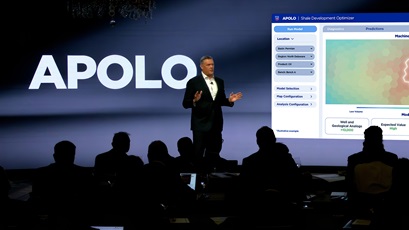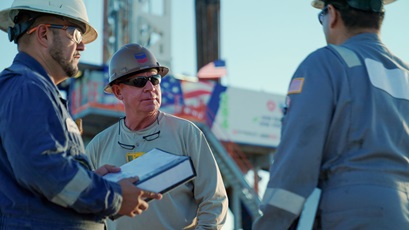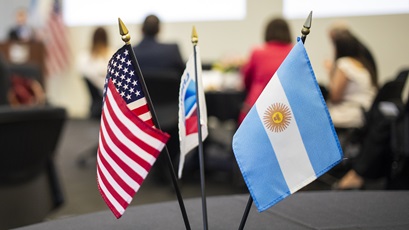our operations
delivering first oil while lowering development costs
2 min read | april 21, 2025
Isral Wright, a Ballymore subsea hardware and installation engineer, helped bring the Ballymore Project to life.
For Isral Wright, working in the Gulf of America (GOA) has proved how success can be transferred from one project to the next.
Fresh from helping bring the industry-first Anchor Project online, Wright played an important role in helping Ballymore, Chevron’s latest deepwater project, achieve first oil.
“Both projects are growing Chevron’s production in the region,” said Wright, a Ballymore subsea hardware and installation engineer. “Getting them online is a big step forward.”
doing more with less
Ballymore, which achieved first oil on April 20, is a deepwater oil field tieback. That means it is connected—or tied back—via a subsea flowline to Chevron’s existing Blind Faith facility approximately three miles away. This approach helps Chevron do more with less.
A subsea tieback connects offshore oil and gas fields, using pipelines and other infrastructure, to existing facilities—in this case, the Blind Faith Platform—allowing Chevron to develop an oil and gas field without having to build a dedicated platform.
A subsea tieback can connect a deepwater oil field to an existing production platform.
Developing a new field as a subsea tieback helps lower the cost of development and enables production to be brought online sooner.
Production from federal waters in the Gulf of America accounts for approximately 14% of U.S. oil production.
why it matters
Ballymore Field coming online—with Chevron’s Pascagoula Refinery ready to take first oil—marks a significant milestone. It ensures sustained Gulf Coast production and strengthens the domestic supply in the Gulf Coast refining network for years to come.
Ballymore is expected to produce up to 75,000 gross barrels of oil per day. Chevron is the primary operator with a 60% interest.
isral wright
ballymore subsea hardware and installation engineer
continued growth
The Ballymore and Anchor projects aren’t the only areas of growth in Chevron’s Gulf portfolio. Production from the Whale Project, in which Chevron has a nonoperating interest, started in mid-2024. The company also began water injection to boost output at its Tahiti and Jack/St. Malo facilities.
Chevron is continuing to build its deepwater portfolio through exploration and development of resources near existing assets.
The company aims to reach 300,000 net barrels of oil-equivalent per day in the Gulf by 2026.
The Gulf of America is home to some of the lowest carbon intensity producing assets in Chevron’s portfolio.
the best of the new and the old
Blind Faith has been operating safely since 2008 and will continue to produce in the years ahead.
Ballymore benefited greatly from leveraging standardized equipment designs and repeatable engineering solutions and technology. In addition, the team was able to apply lessons learned from the Anchor Project to help bring Ballymore online, said Wright.
He said it’s been satisfying to see both projects, after years of effort, come to fruition.
“It’s nice to see,” he said, adding of Anchor: “It’s kind of cool to know I was a part of something that has never been done before.”
topics covered
related content
-

 how APOLO helps chevron pinpoint prime drilling locations
how APOLO helps chevron pinpoint prime drilling locationsour operationsnovember 12, 2025
-

 robotics supports more efficient workplace
robotics supports more efficient workplaceour operationsnovember 10, 2025
-

 the people who power the US energy advantage
the people who power the US energy advantageour operationsnovember 06, 2025
-

 a statement from chevron CEO mike wirth on Argentina
a statement from chevron CEO mike wirth on Argentinaour operationsseptember 24, 2025
chevron email updates
Subscribe to our newsletter to receive news and updates.




